Struggling with noisy, jamming wardrobe doors? The pulley material is often the problem. A poor choice leads to frustration and frequent replacements, costing you time and money.
Wardrobe pulleys are typically made from metal alloys, plastic composites like nylon, or fiberglass. The choice of material directly impacts the door’s smoothness, noise level, and long-term durability. Metal offers strength, while nylon and fiberglass provide quiet operation.
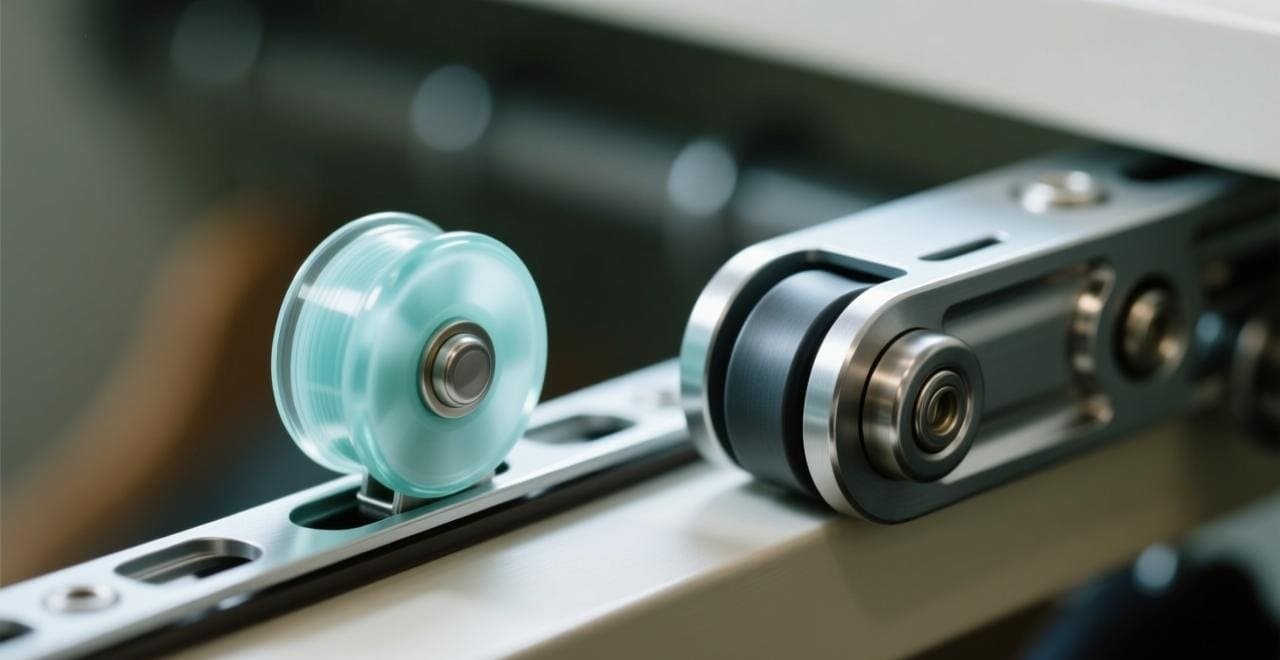
Understanding these materials is the first step. But how do you know which one is right for your specific project? As a factory owner, I see these choices made every day when working with clients like you. The details matter, and getting them right can make a huge difference in the final product’s quality and your customer’s satisfaction. Let’s break it down further so you can make the best purchasing decision.
Which material is used to make pulleys?
Choosing the wrong pulley material can ruin an otherwise perfect wardrobe design. You want smooth, silent doors for your project, but you’re unsure which material actually delivers on that promise.
Pulleys are made from various materials, each with specific benefits. Metal, like zinc alloy or stainless steel, offers high strength. Plastics, especially nylon, provide quiet, smooth gliding. Fiberglass is a durable, non-deforming option popular for many sliding applications.
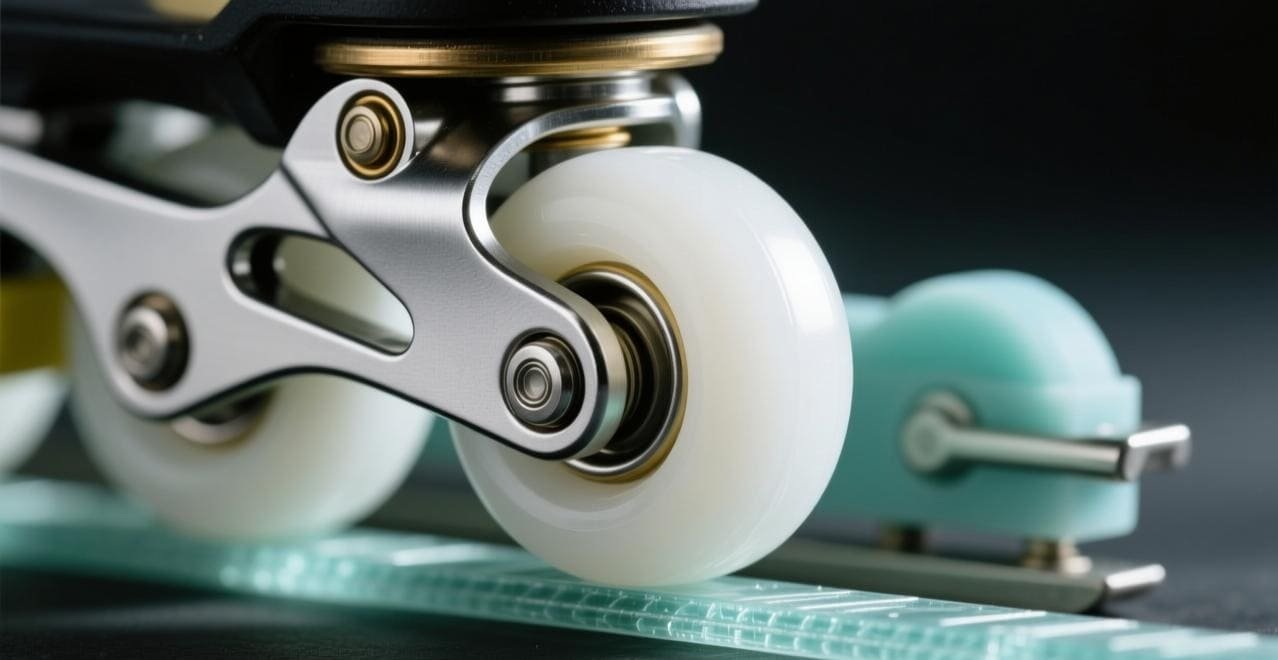
In my years of manufacturing, I’ve worked with every material imaginable for sliding systems. For a purchasing manager, knowing the core types is key to specifying the right product. We mainly deal with three categories for wardrobe pulleys.
Metal Pulleys: The Strength Factor
When a customer comes to me with a project involving very heavy, solid wood or glass doors, I almost always start the conversation with metal pulleys1. Materials like zinc alloy or steel have a very high load-bearing capacity. They don’t deform under pressure, which means they can handle significant weight without failing. This makes them extremely durable. The trade-off can sometimes be noise, but with high-quality bearings, even metal wheels can run smoothly. They are the workhorses of the pulley world.
Nylon Pulleys: The Silent Performer
On the other hand, for most standard residential wardrobes, noise is a bigger concern than extreme weight. This is where nylon shines. Many people think of these as "plastic" wheels, but high-quality pulleys use engineered nylon2, sometimes with carbon fiber mixed in. This material is self-lubricating, which means it glides almost silently along the track. It’s a fantastic choice for bedrooms where you don’t want a loud rumble every time you open the closet.
Fiberglass Pulleys: The All-Rounder
Fiberglass is a great middle-ground option and is very popular. It combines some of the best qualities of both metal and nylon. It’s stronger and more resistant to deformation than basic plastic, but it’s much quieter than metal. It has excellent wear resistance, meaning it will last a long time without developing flat spots. Because of this balanced performance, we see fiberglass pulleys used in a huge range of wardrobe sliding doors. It’s a reliable, safe choice for many applications.
What materials are needed to make a pulley system?
A pulley wheel is just one part of the system. If other components don’t match in quality or material, the entire door can fail. This mismatch creates costly problems and unhappy end-users.
A complete pulley system requires more than just the wheel. It includes the housing (often metal or plastic), bearings (usually steel for smoothness), axles, and mounting brackets. The quality of these supporting materials is just as crucial as the wheel itself for system performance.
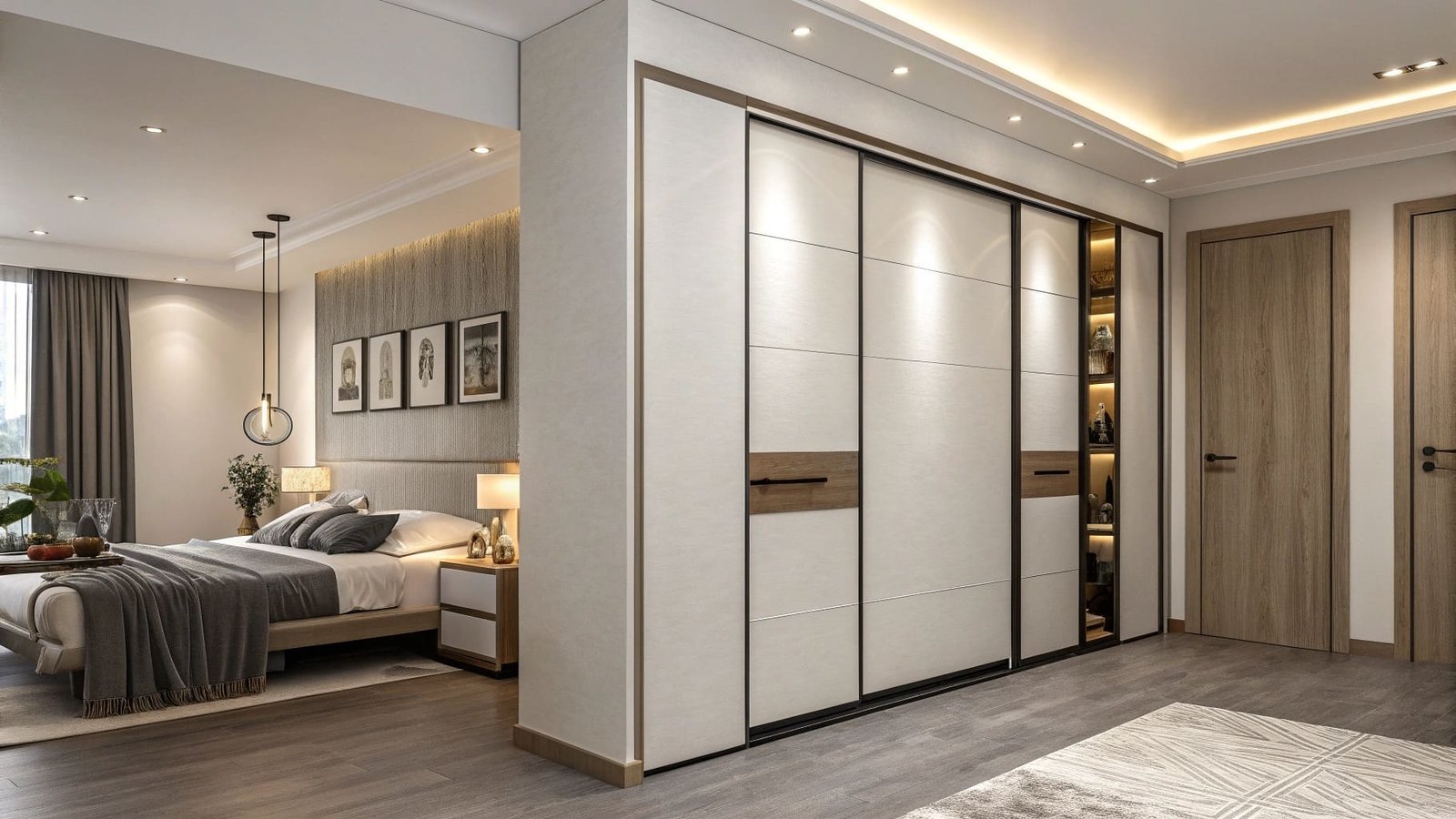
I often have to explain to new buyers that focusing only on the wheel material is a mistake. A great wheel in a terrible housing is a failed product. The entire assembly has to work together. Think of it like a car; you wouldn’t put high-performance tires on a car with a weak engine.
Beyond the Wheel: The Housing and Bearings
The housing is the body that holds the wheel. It can be made of steel for maximum strength or a high-density plastic for a more cost-effective but still durable option. The real secret to a smooth glide, however, is the bearings. Lower-cost pulleys might just have the wheel spinning on a simple metal or plastic axle. But quality systems use sealed steel ball bearings3. This tiny component dramatically reduces friction, allowing the door to move with minimal effort and noise. When a customer like Jacky asks for a "quiet roller," I know he’s really asking for a system with good bearings.
The Importance of Axles and Brackets
The axle is the pin the wheel spins on, and the bracket is what attaches the whole assembly to the door. These parts take a lot of stress. A weak axle can bend, causing the wheel to wobble and jam. A flimsy bracket can deform, making the door hang incorrectly. We use hardened steel for our axles and thick-gauge steel for mounting brackets to ensure they can withstand years of daily use. When you are sourcing, always check the specifications for these "unseen" parts. They are just as important as the wheel.
| Component | Common Material(s) | Key Function |
|---|---|---|
| Wheel | Nylon, Fiberglass, Zinc Alloy | Rolls on the track, supports weight |
| Housing | Steel, High-Density Plastic | Protects and holds the wheel and bearings |
| Bearings | Steel (Ball Bearings) | Reduces friction for a smooth, quiet glide |
| Axle | Hardened Steel | Pin that the wheel rotates on |
| Bracket | Steel, Aluminum | Mounts the entire system to the door |
What are the common pulley materials?
You see many options listed by suppliers, but it’s hard to tell what’s standard. Choosing an obscure material can lead to supply chain issues, inconsistent quality, and difficulty finding replacements.
The most common pulley materials in the wardrobe industry are nylon, fiberglass, and zinc alloy. These materials offer a reliable balance of durability, performance, and cost-effectiveness, making them the go-to choices for manufacturers and contractors worldwide.
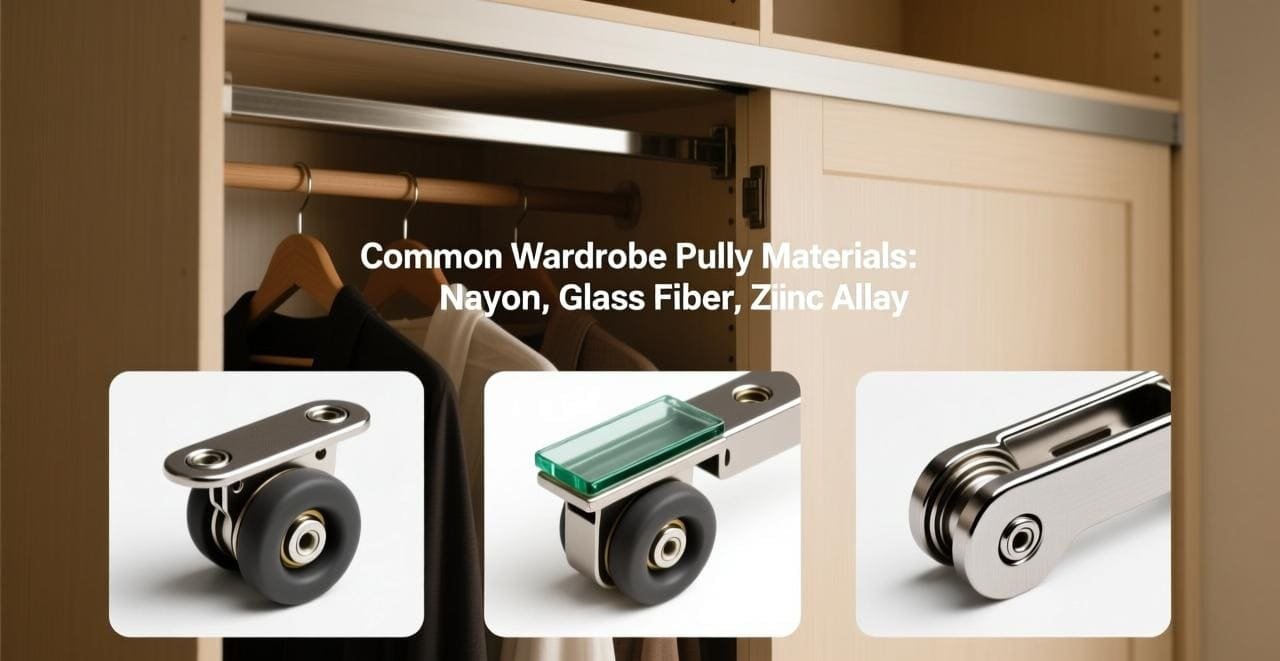
For a purchasing professional who needs to ensure consistency and reliability, sticking to common materials is usually the smartest strategy. In our factory, over 90% of the wardrobe pulleys we produce use one of these three materials for the wheel itself. They have become the industry standard for good reason. Each one serves a clear purpose and has a predictable performance profile, which is exactly what you need when sourcing for large projects.
A Head-to-Head Comparison
To make it easier, I often show my clients a simple chart. It helps them quickly see the trade-offs and decide which material aligns with their project’s budget and quality goals. This kind of clarity is crucial for making an informed decision. For example, if cost is the primary driver for a lightweight door project4, nylon is a clear winner. If the project involves premium, heavy doors5, zinc alloy is the only professional choice. Fiberglass sits comfortably in the middle, offering a safe and reliable option for the majority of standard applications.
| Feature | Nylon | Fiberglass | Zinc Alloy (Metal) |
|---|---|---|---|
| Load Capacity | Moderate | Good | Very High |
| Noise Level | Very Low | Low | Moderate to Low (with good bearings) |
| Durability | Good | Very Good | Excellent |
| Cost | Low | Moderate | High |
| Best Use Case | Standard residential, lightweight doors | Mid-range to high-end residential | Heavy wood/glass doors, commercial |
What is the best material for a pulley system?
Everyone wants the "best" material. But the best for one project might be the worst for another. A one-size-fits-all approach leads to overspending on features you don’t need or underperformance that leads to failures.
The "best" material depends entirely on your application. For heavy-duty doors, a metal pulley system with steel bearings is superior. For standard residential wardrobes where silence is key, a high-quality nylon or fiberglass pulley system is often the ideal choice.
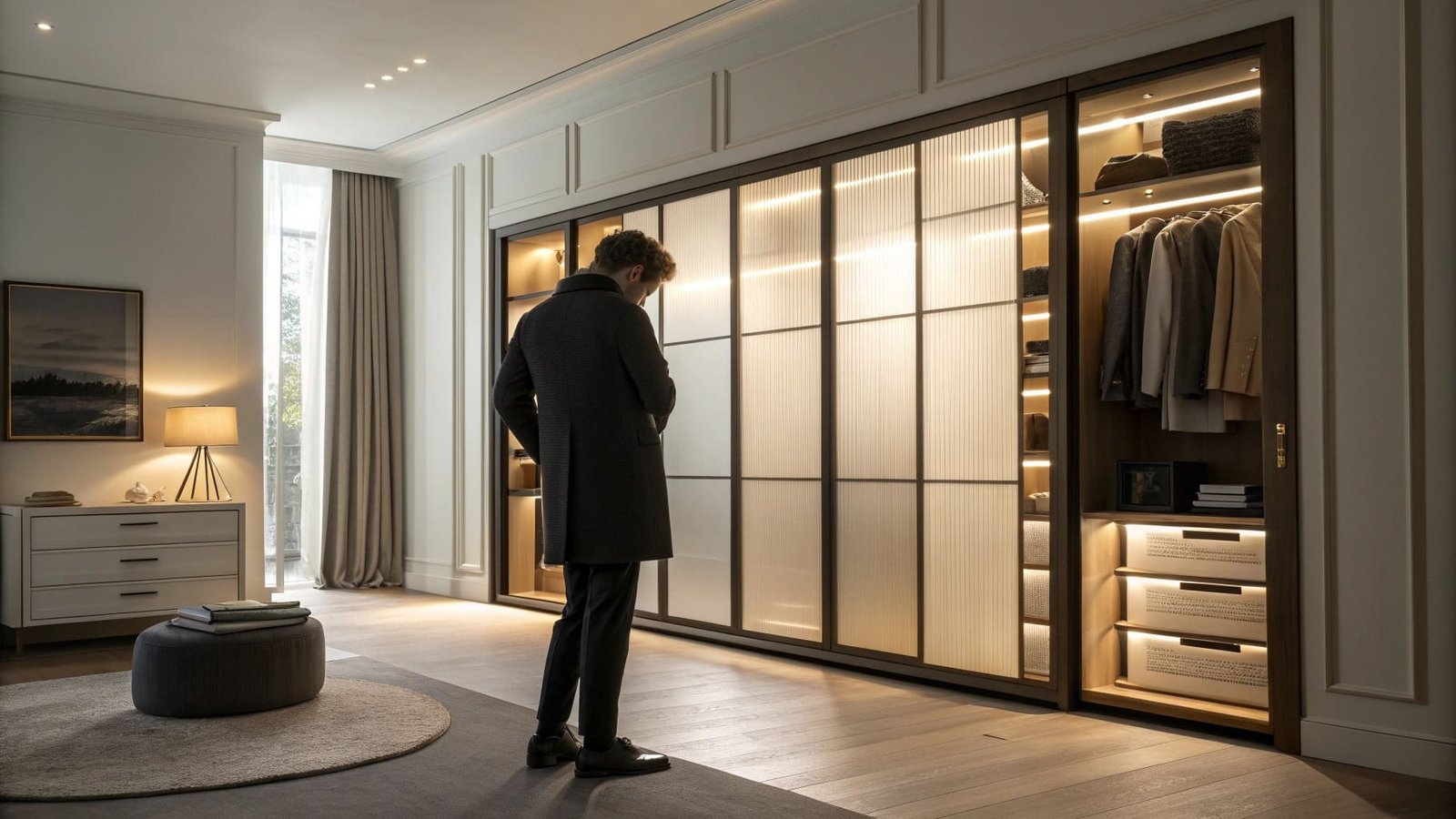
The question I get most often is, "Evan, just tell me which one is the best." My answer is always the same: "Tell me about your door." The best choice is a match between the product and its purpose. Let’s walk through a few common scenarios I discuss with buyers.
Scenario 1: High-End, Heavy Wooden Wardrobe Doors
A customer is building luxury homes and using solid oak wardrobe doors6. Each door weighs over 50kg. In this case, the "best" system is one built for strength. I would specify a pulley with a zinc alloy wheel, a reinforced steel housing, and premium sealed ball bearings. A nylon wheel would deform under this constant load, and a fiberglass one would be at its limit. Here, the durability and high load capacity of metal make it the superior and only correct choice.
Scenario 2: Standard Residential MDF Doors
Now, imagine a large-scale apartment project. The wardrobe doors are standard MDF or particleboard, much lighter. The top priority is smooth, quiet operation that won’t disturb residents, along with reliable performance for years. Here, the "best" system would be a high-quality nylon or fiberglass wheel7. A metal wheel would be overkill, adding unnecessary cost and potentially more noise. The self-lubricating, silent glide of nylon is perfect for this application.
Scenario 3: Custom ODM Project for a Brand
Sometimes a distributor like Jacky wants to create his own branded line of hardware. He needs a specific balance of price and performance to compete in his market in Canada. For this, we work together to find the "best" solution. We might use a fiberglass wheel for durability but pair it with a cost-effective plastic housing to manage the price point. Or we could develop a custom nylon blend that offers better wear resistance. This collaborative process ensures the final product is perfectly tailored to the client’s business goals.
Conclusion
Choosing the right wardrobe pulley material isn’t about finding the single best option. It’s about selecting the right one for your specific needs, balancing strength, silence, and cost.
-
Explore this link to understand why metal pulleys are essential for heavy loads and their durability. ↩
-
Discover the advantages of engineered nylon in pulleys for quiet and efficient operation. ↩
-
Explore this link to understand how sealed steel ball bearings enhance performance and longevity in door systems. ↩
-
Explore this link to understand the advantages of lightweight door materials, which can help you make informed choices for your projects. ↩
-
Discover the best materials for heavy doors to ensure durability and performance in your construction projects. ↩
-
Explore the advantages of solid oak wardrobe doors, including durability and aesthetic appeal, to enhance your luxury home projects. ↩
-
Learn why high-quality nylon or fiberglass wheels are ideal for smooth and quiet door operation, perfect for residential settings. ↩

